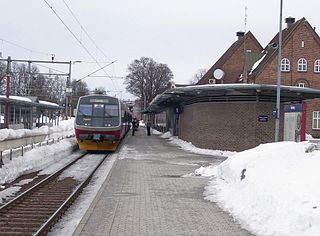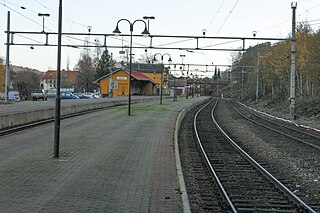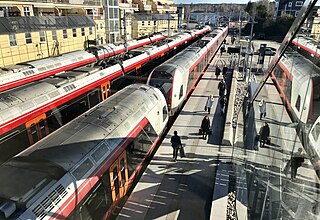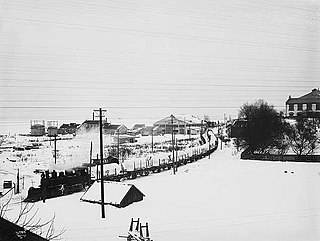
The Vestfold Line is a 137.79-kilometer (85.62 mi) railway line which runs between Drammen and Eidanger in Norway. The line connects to the Drammen Line at the northern terminus at Drammen Station and continues as the Bratsberg Line past Skien Station. The line is exclusively used for passenger trains, which are provided by Vy, which connect northwards to Oslo and south-westwards to Grenland. The 13-kilometer (8.1 mi) section from Eidanger to Skien is often colloquially included in the Vestfold Line.The standard gauge line is electrified at 15 kV 16.7 Hz AC and has twelve remaining stations. The Vestfold Line runs through the coastal region of Vestfold and serves major towns including Holmestrand, Tønsberg, Sandefjord and Larvik, as well as Sandefjord Airport, Torp.

The Arendal Line is a 45-kilometer (28 mi) long railway line between Arendal and Simonstad in Norway. At Nelaug, 37 kilometers (23 mi) north of Arendal, the line intersects with the Sørland Line. The southern section is electrified and provides a feeder passenger service. The line originally ran 90 kilometers (56 mi) north from Arendal to Treungen and the lake Nisser, but the upper-most part has been removed. The line is owned by the Bane NOR and operated by Go-Ahead Norge using Class 69 trains.

Asker Station is a railway station located in downtown Asker, Norway. Situated on the Drammen Line, 23.83 kilometers (14.81 mi) from Oslo Central Station, it also serves as the terminus of the Asker Line and the Spikkestad Line. The station is located just southwest of the Asker Tunnel and the Skaugum Tunnel, and just northeast the Lieråsen Tunnel. Vy serves the station with local, regional and intercity trains. It is also served by the Airport Express Train and serves as the main bus terminal for the town. The station has six tracks and four platforms, consisting of two island platforms and two side platforms. The station had 8,400 daily passengers in 2008.

Sandvika Station is a railway station located at Sandvika in Bærum, Norway. Situated on the Drammen Line, 14.14 kilometers (8.79 mi) from Oslo S, it also an intermediate station of the Asker Line. Vy serves the station with local and regional, with about 7,000 passengers using the station daily. It is also served by the Airport Express Train and serves as the main bus terminal for the town. The station is elevated and has two island platforms and four tracks.

Hamar Station is a railway station of the Dovre Line and the Røros Line located in downtown Hamar, Norway. Located 126.26 kilometers (78.45 mi) from Oslo Central Station, it is served by long-distance and regional trains on the Dovre Line, as the terminus for regional trains on the Røros Line. All trains are operated by SJ Norge, except the regional trains between Lillehammer and Oslo, which are operated by Vy. A side platform and an island platform are in regular use. The station handled 1,062,300 passengers in 2008.

Tønsberg Station on the Vestfold Line, is the main railway station in the town of Tønsberg in Tønsberg Municipality in Vestfold county, Norway. The station is located in the downtown area, to the east of the hill Slottsfjellet. It is located at an altitude of 14.5 meters (48 ft) above mean sea level, and is 115.68 kilometers (71.88 mi) from Oslo Central Station. The current station is from 1915.

Holmestrand Station was a railway station on the Vestfold Line located in the town of Holmestrand in Vestfold, Norway.

The Roa–Hønefoss Line is a 32-kilometer (20 mi) long, single track railway line between Roa and Hønefoss in Norway. At Roa Station, the line connects to the Gjøvik Line, while at Hønefoss Station, it connects to the Randsfjorden Line and the Bergen Line. The line runs through Akershus and Buskerud counties and allowed the Bergen Line access to Oslo at Oslo East Station.

The Brevik Line is a 10-kilometer (6.2 mi) railway which runs from Eidanger to Brevik in Porsgrunn, Norway. The single track and electrified branch line of the Vestfold Line is exclusively used for freight traffic to Norcem Brevik hauled by CargoNet.

The Ålgård Line is a closed, but not abandoned, railway line between Ganddal and Ålgård in Rogaland, Norway. The 12.24-kilometer (7.61 mi) line was built as a narrow gauge branch line of the Jæren Line by the Norwegian State Railways (NSB) and opened in 1924. It runs through the villages of Foss-Eikeland and Figgjo in Sandnes to Ålgård in Gjesdal. Several proposals were made for the Ålgård Line to become the first part of the main line from Stavanger to Oslo, but instead the Sørlandet Line was connected to the Jæren Line in 1944. At the same time, the Ålgård Line was upgraded to standard gauge.

Mysen Station is a railway station located at Mysen in Eidsberg, Norway. Situated 64.77 kilometers (40.25 mi) from Oslo Central Station, it is served hourly by the L22 service of the Oslo Commuter Rail. It is the terminus of most L22 services. The station had 251,000 boarding and disembarking passengers in 2012.

The Horten Line was a 7.0-kilometer (4.3 mi) branch railway line of the Vestfold Line which ran from Skoppum to Horten, Norway. The line opened as a narrow gauge line on 13 October 1881, the same day as the Vestfold Line. The latter had been proposed to run through Horten, but instead a branch line was chosen. The Horten Line converted to standard gauge in 1949 and electrified in 1957. Passenger transport ran until 1968 and freight trains until 2002. The line was demolished in 2009. Skoppum Station and Borre Station have both been preserved as examples of Balthazar Lange's Swiss chalet style architecture.

The Holmestrand–Hvittingfoss Line or HVB is an abandoned railway between Holmestrand to Hvittingfoss in Norway. It consisted of two sections: a 13.4-kilometer (8.3 mi) line from Holmestrand to Hillestad and a 10.4-kilometer (6.5 mi) section from Hof to Hvittingfoss. The two parts were connected by a 6 kilometers (4 mi) section of the Tønsberg–Eidsfoss Line. At Holmestrand Station, the line connected to the Vestfold Line of the Norwegian State Railways. HVB was opened on 30 September 1902 and closed on 1 June 1938. The main purpose of the line was the transport of wood pulp at Hvittingfoss, although it was also used for passenger transport until 1931.

The Tønsberg–Eidsfoss Line or TEB is an abandoned railway between Eidsfoss and Tønsberg in Vestfold county, Norway. In use from 21 October 1901 to 31 May 1938, the private railway connected the area of Hof to Tønsberg, the coast and the Vestfold Line of the Norwegian State Railways. The main purpose of the 48.10-kilometre (29.89 mi) narrow gauge railway was to connect Eidsfos Verk to the mainline, although the railway also operated passenger trains. The line shares 6 kilometres (3.7 mi) with the Holmestrand–Vittingfoss Line (HVB), the two which from 1934 were operated by the same company, Vestfold Privatbaner.

Eidanger Station is a disused railway station at Eidanger in Porsgrunn, Norway. Located at the intersection of the Bratsberg Line, Brevik Line and Vestfold Line, it is located 192.60 kilometers (119.68 mi) from Oslo. The station buildings were designed by Balthazar Lange.

Oslo Commuter Rail is a commuter rail centered in Oslo, Norway, connecting the capital to six counties in Eastern Norway. The system is operated by Vy and its subsidiary Vy Gjøvikbanen, using Class 69 and Class 72 electric multiple units (EMU). The network spans eight routes and 128 stations, with Oslo Central Station (Oslo S) as the central hub. The trains run on 553 kilometers (344 mi) of electrified mainline railway owned by the Bane NOR. Deficits are financed by the Norwegian Ministry of Transport, although the network also has a ticketing cooperation with Ruter, the public transport authority in Oslo and Akershus. The network is the longest commuter rail network in the Nordic countries, and among top ten in Europe.

Skoppum Station is a railway station on the Vestfold Line in the village of Skoppum, in Horten, Norway. Situated 99.54 kilometers (61.85 mi) from Oslo Central Station, it serves an hourly regional service operated by Vy. The station has two platforms and is itself located on an island platform, giving Skoppum a keilbahnhof design. The station building was designed by Balthazar Lange in Swiss chalet style.

Kråkstad Station is a railway station located at Kråkstad in Ski, Norway. Situated 30.09 kilometers (18.70 mi) from Oslo Central Station, it is served hourly by the L22 service of Vy's Oslo Commuter Rail. The station opened on 24 November 1882 with a station building designed by Balthazar Lange in Swiss chalet style. It has been listed as a cultural heritage site. The station received a revamp in 2014. The station had 92,000 boarding and disembarking passengers in 2012.
Vestfold Privatbaner was a private railway company which operated two railways in Vestfold, Norway, the Holmestrand–Vittingfoss Line (HVB) and the Tønsberg–Eidsfoss Line (TEB). The company was created in 1934 as a merger between the two former operating companies of each of the two lines, but Vestfold Privatbaner closed operations already on 1 June 1938.
Nystrand Station is a disused railway station located at Eidanger in Porsgrunn, Norway, on the Brevik Line. Designed by Paul Due, it was located 195.35 kilometers (121.38 mi) from Oslo. The station opened on 15 July 1895, three months before the rest of the line. Nystrand was largely used for recreational visits to Eidangerfjorden from townspeople in Porsgrunn and Skien. The station was served by a commuter train service until 1964, and has not seen regular calls by trains since 1968. It was formally closed on 31 May 1970. The station building has been preserved at Porsgrunn Town Museum.


















